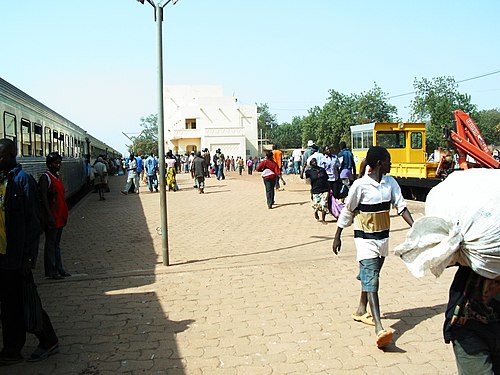Koudougou Kʋdgo (Mossi) | |
|---|---|
 TheGrand marché (Main Market) of Koudougou | |
Location within Burkina Faso,West Africa | |
| Coordinates:12°15′N2°22′W / 12.250°N 2.367°W /12.250; -2.367 | |
| Country |  Burkina Faso Burkina Faso |
| Region | Centre-Ouest Region |
| Province | Boulkiemdé Province |
| Department | Koudougou Department |
| Elevation | 282 m (925 ft) |
| Population (2019 census)[1] | |
• Total | 160,239 |
| Time zone | UTC+0 (GMT) |
| Area code | +226 50 |
Koudougou (Mossi:Kʋdgo) is a city inBurkina Faso'sBoulkiemdé Province. It is located 75 kilometres (47 mi) west ofOuagadougou, the capital ofBurkina Faso. With a population of 160,239 (2019),[1] it is thethird most populous city in Burkina Faso afterOuagadougou andBobo Dioulasso, and is mainly inhabited by theGurunsi andMossi ethnic groups.[2] Koudougou is situated on theonly railway line in Burkina Faso and has some small industries, a market, auniversity and provincial government offices.

Situated on the Mossi Plateau, the city is 75 kilometres (47 mi) west ofOuagadougou. In 1952 it was connected by rail to Ouagadougou andAbidjan. It is situated along the N13 road south ofSabou and north ofYako. The N21 road connects the city toRéo and the N14 connects it withDédougou.
Although the city's administrative borders used to extend further, the city currently encompasses 15 surrounding villages.



The economy of the city is dominated by agriculture with annual GDP for the city amounting to around 17.5 billion CFA (apx. $36 million).[3] The city has small industries such as a soap,shea butter,cotton and various textile factories. As of February 2007, the city had radio-television production and broadcasting installations forTele-Yaka, a clothing recycling and manufacturing workshop, an experimental mango and green-leaf vegetable plantation, a metal forge for construction and maintenance of farming tools and implements, a metal waste-management and metal engineering workshop geared towards machine parts and motor components, an electronics repair shop and an open-air exhibition space for local sculptors.[citation needed]
| Type of Activity | Men | Women | Together |
|---|---|---|---|
| Agriculture | 86,3% | 89,7% | 88,1% |
| Processing | 1,1 | 3,7 | 2,5 |
| Construction | 1,2 | 0,0 | 0,6 |
| Trade | 2,7 | 3,1 | 3,0 |
| Transportation and Telecommunications | 0,4 | 0,1 | 0,2 |
| Merchant Services | 3,8 | 1,4 | 2,5 |
| Other services | 4,4 | 2,0 | 3,1 |

The city has a railroad station along theAbidjan – Ouagadougou Railway. As of June 2014Sitarail operated a passenger train along the line three times a week in each direction.[4]Ouagadougou International Airport is approximately 141 km southeast of central Koudougou and as of June 2014 had regularly scheduled flights to most major cities in West Africa as well as Paris, Brussels and Istanbul.
Since 2005 the city is home to theUniversity of Koudougou (there were around 5,600 students enrolled in 2010/2011)[5] and in 2012 a vocational school opened. Primary school enrollment in 2007-2008 was 79.2% and secondary school enrollment was 20.3%.[3]
The city has a fewsoccer clubs includingl'Association des Jeunes Sportifs de Koudougou (AJSK),l'AS des Employés de Commerce de Koudougou (ASEC-K),le Bouloumpoukou FC (BPFC),le Bouloumpoukou Stade (BPS),l'Association des jeunes footballeurs (AJF), andle Jeunesse Club Boulkiemdé.They all play at theStade Balibiè.
Hilgers, M.,Une ethnographie à l'échelle de la ville. Histoire et reconnaissance à Koudougou, Karthala, Paris, 2009.